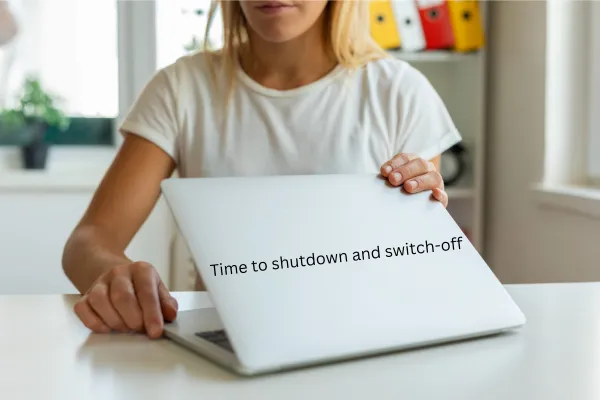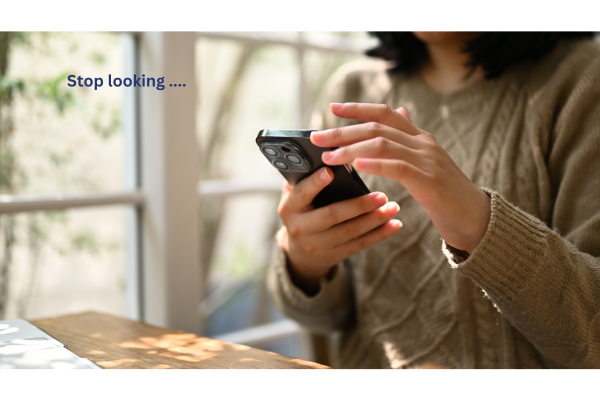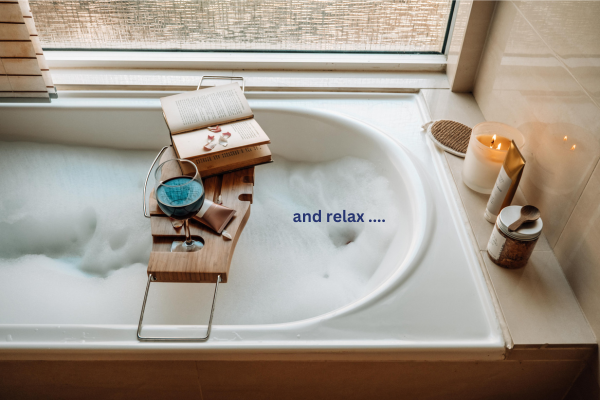Welcome to Your Path to Balance - Mindset and Self-Care Blog
A space dedicated to providing you with valuable insights, practical tips and inspiring stories that can help you navigate your self-care and mindset journey. Dive into topics around emotional resilience, positive mindset, healthy habits, work-life balance, stress management, relaxation techniques, mental well being and physical health. Learn how using powerful mindset tools such as NLP, Hypnosis and TLT can support you in achieving your self-care goals.

Finding Your Off Switch - 5 Top Tips for Unwinding After Work
In the hyper-connected world we live in, it can be challenging to switch off after a long day at work. The constant barrage of emails, notifications and to-do lists can leave us feeling mentally drained and overwhelmed. This can be particularly difficult if you have a Type A personality like me, with high levels of ambition and drive for achievement, which often exacerbate these feelings. Quieting your mind and letting go of work-related thoughts can also seem impossible, especially if you’re always striving for perfection and feeling guilty when you're not being productive.
Then there’s working from home, which adds another layer of complexity to this challenge. Without the physical boundaries of a traditional office environment, it can be hard to separate your work life from your personal life. When I first started out, my office was my sofa as I didn’t have the luxury of a home office at the time, so the lines between work and personal life were completely blurred, making it even more challenging to switch off and unwind at the end of the day.
Top 5 Tips for Unwinding
Learning how to properly wind down and disconnect from your workspace is crucial for your mental well-being and overall productivity. If you'd like some actionable tips that can empower you to regain control over your relaxation and prioritise your mental and emotional health, then read on to discover my top 5 tips to support you on your path to unwinding after a demanding day.
1. Establish a Post-Work Routine
The key to winding down is to develop a consistent post-work routine that helps you transition away from work and into personal time.
Tips for Getting Started
Determine a specific time you officially end your workday - Having a clear end time helps create structure and consistency in your routine, making it easier to mentally transition out of work mode. By setting a definitive time boundary, you create a sense of closure that allows you to fully disengage from work-related tasks and shift your focus to personal activities.
Shutdown your PC or laptop - By shutting devices down, you are physically and symbolically disconnecting from work-related tasks, creating a visual cue that your workday has ended and reducing temptation to continue working after hours. I know from personal experience that if I don’t do this, I can find myself returning to my laptop for a ‘quick look’ and before I know it, I’m working until midnight.
Close your home office door - This adds another layer of separation between your work environment and your personal space. It creates a physical barrier that helps shut work away and signals to yourself that you are transitioning into personal time. If you work from your sofa or the dining table and that’s not possible, try moving to a different room or area of your home when you're done with work - this physical relocation can help create a mental separation.
Switch on to an activity that promotes relaxation and mental disengagement from work tasks: - Find an activity you enjoy. For example, I like listening to an audiobook or podcast while preparing dinner. This allows me to unwind while still staying mentally engaged, which is something my Type A personality gravitates towards.
The key is to create a daily ritual tailored to you that signals to your brain that it's time to shift your focus away from work and embrace the relaxation of your personal time.

2. Avoid Checking Emails After Official Work Hours
As Type As, we’re driven by a strong sense of responsibility and accountability. A common problem is feeling a constant need to stay on top of work and be responsive to emails. An urge to check emails outside of work hours may also stem from the high standards you set yourself as you strive for perfection. Recognising this in yourself is the first step.
Tips for Getting Started
Try refraining from looking or responding to emails after the workday has ended. Instead, switch on to an activity that improves your well-being, such as meeting up with friends for dinner. Reserve email checks for when your working day starts again.
The next day, ask yourself how you feel. You can do this with the help of these journal prompts and see what comes up for you:
How did it feel to resist the urge to answer work emails last night? Describe any emotions or thoughts that came up for you during this experience. This question helps you explore your emotional response to refraining from checking work emails and provides insight into any underlying feelings of relief, stress, or anxiety associated with disconnecting.
What’s the worst thing that happened because you didn’t check your emails? By asking this question, you can challenge your assumptions about the consequences of not checking work emails and often realise that the perceived negative outcomes were not as significant as anticipated, thereby validating your decision to disconnect.
Did you notice any improvements in your stress levels or overall sense of well-being after disconnecting from work emails and switching on to something else enjoyable? This question encourages you to reflect on the tangible benefits of prioritising your well-being over work. By acknowledging any improvements in stress levels or overall well-being, you can reaffirm the value of setting yourself boundaries around email usage.
As you reflect on your experience using the provided journal prompts, allow yourself to explore any emotions or thoughts that arise without judgment. This exercise allows you to challenge assumptions about the consequences of disconnecting from work emails and recognise the positive impact on your stress levels and overall sense of well-being.
Once you understand your thoughts and emotions, set boundaries around email usage, knowing that you are empowering yourself to cultivate a healthier work-life balance.

3. Engage in a Hobby
Allocate some time after work to indulge in activities that bring you joy and fulfilment. Engaging in a hobby offers a precious opportunity to disconnect from work-related stressors and fully immerse yourself in activities that rejuvenate you. Whether it's painting, cooking, or even dancing, selecting a hobby that aligns with your interests and passions can serve as a vital tool for unwinding and recharging after a demanding day.
Why It Matters
Participating in a hobby not only allows you to redirect your focus away from work but also provides a therapeutic outlet for releasing built-up tension and stress. Immersing yourself in creative or hands-on activities can stimulate your mind, cultivating a sense of accomplishment and satisfaction. By embracing activities that bring you joy, you can replenish your energy reserves and find a more balanced perspective, ultimately enhancing your ability to unwind and relax after the pressures of the workday.
Tips for Getting Started
Identify Your Passions - Reflect on activities that ignite your passion and bring you a sense of fulfilment. Whether it's reigniting a childhood hobby or exploring a new interest, prioritize activities that resonate with your values and preferences.
Make Time for Your Hobby - Carve out dedicated time in your daily or weekly schedule to engage in your chosen hobby. Treat this time as a non-negotiable commitment and create a conducive environment free from distractions to fully immerse yourself in the experience.
Start Small - Resist the urge to master your hobby overnight and instead focus on enjoying the process of exploration and discovery. Begin with manageable tasks or projects, gradually building your skills and confidence over time.
Embrace Imperfection - Release the pressure to achieve perfection and embrace the inherent learning curve of your chosen hobby. Embrace mistakes as valuable learning opportunities and allow yourself the freedom to experiment and express yourself without fear of judgment.
Connect with Others - Seek out opportunities to connect with fellow hobbyists through clubs, classes, or online communities. Building connections with like-minded individuals provides not only valuable support and inspiration but also opportunities for collaboration and shared experiences.
By incorporating a hobby into your post-work routine, you can cultivate a more holistic approach to relaxation and well-being, allowing yourself the time and space to unwind, recharge, and reconnect with activities that bring you joy and fulfilment.

4. Practice Mindfulness
Incorporate mindfulness practices into your post-work routine to cultivate a sense of calm and presence. This could involve mindfulness meditation, deep breathing exercises, or simply focusing on the sensations of your body and surroundings. By tuning into the present moment and letting go of work-related thoughts, you can reduce stress and promote relaxation.
Tips for Getting Started
Mindful Breathing - Take a few moments to focus on your breath, inhaling deeply through your nose and exhaling slowly through your mouth. Notice the sensation of the breath as it enters and leaves your body, allowing yourself to fully immerse in the rhythmic flow of inhalation and exhalation.
Body Scan Meditation - Set aside time to conduct a body scan meditation, where you systematically observe and release tension from different parts of your body. Begin at the crown of your head and gradually work your way down to your toes, paying attention to any areas of tightness or discomfort and consciously relaxing them.
Sensory Awareness - Engage your senses by tuning into the sights, sounds, smells, tastes, and textures around you. Take a moment to appreciate the beauty of nature, savour the flavour of your favourite tea, or revel in the warmth of sunlight streaming through your window. By immersing yourself in the present moment, you can anchor yourself in a state of mindfulness and tranquillity.
Guided Meditation - Utilise guided meditation recordings or mindfulness apps to facilitate your practice. These resources offer structured guidance and support, making it easier to cultivate mindfulness, especially if you're new to the practice. Experiment with different guided meditations to find ones that resonate with you and suit your preferences.
By incorporating mindfulness into your post-work routine, it can help you transition from the busyness of the workday to a state of relaxation. Whether it's a brief meditation session before bed or a mindful breathing exercise during your evening walk, prioritising mindfulness allows you to nurture your mental well-being and wind down.

5. Pamper Yourself
After a long day of work, taking time to pamper yourself can be a wonderful way to unwind and show yourself some much-needed care. Pampering activities can range from simple self-care routines to more indulgent experiences that allow you to relax and rejuvenate.
Tips for Getting Started
Create a Spa-Like Atmosphere at Home - Transform your bathroom into a mini-spa by dimming the lights, lighting scented candles, and playing soothing music. Take a long, warm bath with essential oils or bath salts to relax your muscles and calm your mind.
Indulge in Skincare Routines - Dedicate time to pamper your skin with a thorough skincare routine. Use face masks, exfoliants, and moisturizers to give your skin the attention it deserves. The process can be both relaxing and revitalising.
Enjoy a Massage - If possible, book a professional massage or ask a partner or friend to give you a gentle massage. Alternatively, you can use self-massage techniques to relieve tension in your neck, shoulders, and back.
Practice Aromatherapy - Use essential oils to create a calming atmosphere. Scents like lavender, chamomile and eucalyptus can help reduce stress and promote relaxation. Consider using a diffuser or applying diluted essential oils to your pulse points.
Treat Yourself to a Favourite Activity - Sometimes, pampering yourself is as simple as enjoying a favourite activity. Whether it's watching a movie, reading a book, or enjoying a cup of tea, take time to do something that brings you joy and helps you unwind.
Pampering yourself after work is a valuable way to show self-love and care. By incorporating these practices into your routine, you can create a soothing end to your workday, allowing you to fully relax and recharge.
By implementing these tips, you can cultivate a balanced approach to unwinding after work, promoting your mental well-being and overall productivity. Remember, it's important to find what works best for you and to make time for activities that bring you joy and relaxation.
Taking steps to switch-off after work is a great way to embrace self-care - want to know more about how you can integrate self-care into your busy life? Get my FREE ultimate self-care guide here
Copyright © 2024 Coni Moloney - All rights reserved.
© 2024 All Rights Reserved, Coni Moloney

